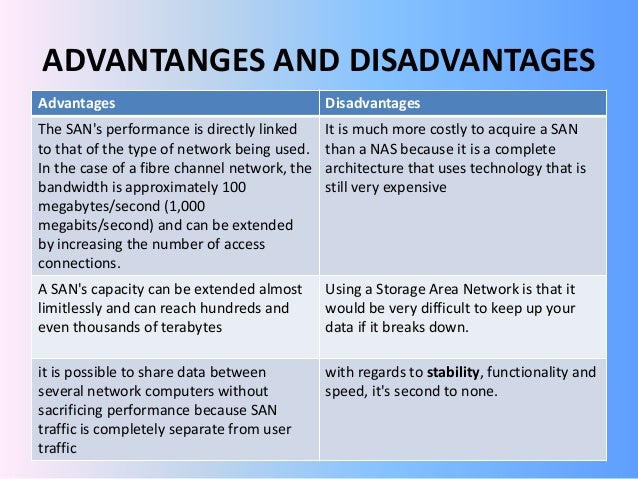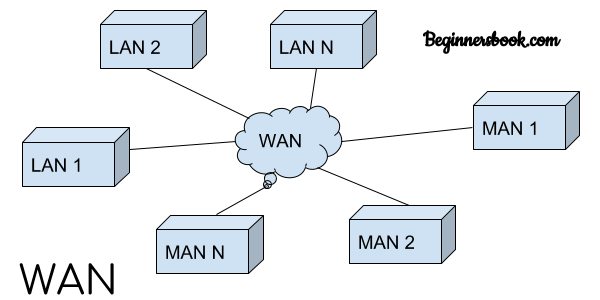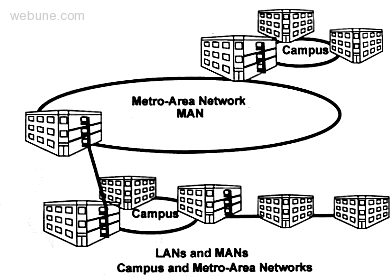A metropolitan area network (MAN) is a large computer network that usually spans a city or a large campus. A MAN Network is optimized for a larger geographical area than a LAN, ranging from several blocks of buildings to entire cities.
MAN Networks are formed by connecting multiple LANs. Thus, MAN Networks are larger than LANs but smaller than wide-area networks (WAN).
The purpose of MAN (Metropolitan Area Network) is to provide the link to the internet in the long run. MAN Network provides Internet connectivity for LANs in a metropolitan region, and connect them to wider area networks like the Internet. ” It can also be used in cable television.

The primary use of metropolitan area networks is the customer that has high-capacity needs in a metropolitan area. A MAN is intended to provide the required capacity at a lower cost and greater efficiency than obtaining an equivalent service from the local telephone company
How Does a Metropolitan Area Network Work?
Metropolitan Area Network is larger than LAN and smaller than WAN. It is generally applied to connect geographically dispersed LANs. Therefore the goal of MAN is to develop a communication link between two independent LAN nodes.
A MAN Network is usually established using optical fiber. The network is established using routers and switches. A switch is a port which is active in handling the filtration of data usually coming in the form of frames. Any switch acts as a dual-port, at one end it is handling filtration of data and at the other end managing connections.

The router is another device for facilitating the network connection. A router helps the data packets to identify the path to be taken. Hence, in other words, it keeps an eye on the data transfer. MAN (Metropolitan Area Network) is usually operated over an area of up to 5 to 50kms.
Characteristics of Metropolitan Area Network
- Network size generally ranges from 5 to 50 km. It may be as small as a group of buildings on campus to as large as covering the whole city.
- In general, a MAN is either owned by a user group or by a network provider who sells service to users, rather than a single organization as in LAN.
- Data rates are moderate to high.
- It facilitates the sharing of regional resources.
- They provide uplinks for connecting LANs to WANs and the Internet.
Uses of Metropolitan Area Network (MAN)
Some of the Uses of MAN are:-
Metropolitan Area Network 3. Bus network, Computer network, Ethernet 830 Words 3 Pages. Supported the project while others tried to oppose it. After conducting researches regarding this matter, I, as one of the members of the local committee, would like to share my opinion on the advantages and disadvantages of building the proposed factory at. Disadvantages of Man (Metropolitan Area Network) It is difficult to manage when we have large network. For its installation we need skilled or experts and also required a network administrator. They all increase the overall installation and management costs.
- Digital cable television
- Used in government agencies
- University campuses
- Cable broadband
- Used to connect several branches of the local school
- In hospital (for communication between doctors, research offices, labs)
- A network of fire stations
- In airports
- Networking between community colleges within the country
- Used in public libraries
Advantages of a MAN Network
There are many advantages of the MAN network, some of them given below.
1: Less Expensive:
It is less expensive to attach MAN with WAN Network. MAN gives you good efficiency of data. All data on MAN is easily manageable in a centralized way.
2: Sending Local Emails:
You can send local emails fast and free on MAN.
3: High Speed than WAN:
The speed of data can easily reach 1000 Mbps, as MAN uses fiber optics. Files and database transfer rates are fast.
4: Sharing of the Internet:
With the installation of MANs, users can share their internet connection. In this way, multiple users can get the same high-speed internet.
5: Conversion of LAN to MAN is Easy:
MAN is a combination of two or more LAN network. So it is a faster way to connect two LAN networks together. It is possible by the fast configuration of links.
6: High Security:
MAN’s has a high-security level than WAN.
Disadvantages of MAN Network
1: Difficult To Manage:
It is very difficult to manage if the size and number of LANs network increase. This is due to security and extra configuration problems.
2: Internet Speed Difference:
As it cannot work on phone copper wires. Copper wires affect the speed of MAN.So high cost is needed for fiber optics.
3: Hackers Attack:
In this network, there is a high risk of attacking hackers as compared to LAN. So data may be a leak. Highly security staff is the need in MAN.
4: Technical Staff Requires to Set up:
Highly technical people require to setup MAN. The technical people are network administrators and troubleshooters.
5: Need More wires:
In MAN more than LAN network, cables require. As you know, it is a combination of two LANs.
A wide area network (WAN) is a telecommunications network, usually used for connecting computers, which spans a wide geographical area, such as between different cities, states, or even countries. WANs typically are used by corporations or organizations to facilitate the exchange of data between their computers in dispersed offices. Across all industries, most large corporations with facilities at multiple locations use WANs, and even small businesses with just two remote sites increasingly use WANs. Most WANs link two or more local area networks (LANs), and the Internet is in essence a very large WAN.
WANS VERSUS OTHER NETWORKS
Although WANs serve a purpose similar to that of LANs, WANs are structured and operated quite differently. The user of a WAN usually does not own the communication lines that connect the remote computer systems but instead subscribes to a service through a telecommunications provider. Unlike LANs, WANs typically do not link individual computers, but rather are used to link LANs in what are known as internetworks, using devices called routers and remote bridges. WANs also transmit data at much slower speeds than LANs, most commonly at about 1.5 megabits per second (Mbps) or less, instead of the tens, hundreds, or even thousands of Mbps achieved by LANs. WANs are structurally similar to metropolitan area networks (MANs), but are typically slower and provide communications links for distances greater than 50 kilometers.
WANs have existed for decades, but new technologies, services, and applications have developed over the years. WANs were originally developed for digital leased-line services carrying only voice, rather than data. As such, they connected the private branch exchanges (PBXs) of remote offices of the same company. WANs are still used for voice services, but are used most heavily for data and, recently, also for images, such as video conferencing. WAN usage is growing, as more companies have installed LANs and as more affordable internetworking equipment has become available.
.jpg)
TECHNOLOGICAL PROFILE
WAN technology is diverse and complex. There are any number of ways to establish a network connection between two points, ranging from systems based on traditional metal wires or cables to fiber-optic or radio-frequency communications. In addition to the connection medium, there are a variety of networking protocols to choose from based on the kinds of networks being connected and the capacity and reliability requirements for the data.
WANs are either point-to-point, involving a direct connection between two sites, or operate across packet-switched networks, in which data is transmitted in packets over shared circuits. Point-to-point WAN service may involve either analog dial-up lines, using a modem to connect the computer to the telephone line, or dedicated leased digital telephone lines, also known as 'private lines.' Analog lines, which may be either part of a public-switched network or leased lines, are suitable for batch data transmissions, such as nonurgent order entry and point of-sale transactions. Dedicated digital phone lines permit uninterrupted, secure data transmission at fixed costs. Point-to-point WAN service providers include both local telephone companies and long distance carriers, such as AT&T and MCI WorldCom.

POINT-TO-POINT SERVICES.
A leading type of point-to-point WAN technology in North America is TI, which is based on a method of dividing a digital line service with a rate of 1.544 Mbps into 24 channels of 64 Kbps each. By modern standards this rate is relatively slow compared to LAN technology and compared to the increasing corporate demands placed on LANs. The cost of setting up and leasing a TI (or the faster T3) represents a sizable outlay for companies. In the early 1990s nearly all WANs used Ti or other leased lines, which are leased from a telecommunications carrier, but this changed rapidly as cheaper and faster alternatives emerged. Many observers have forecast the sharp decline of leased-line services once infrastructure is in place to better support the newer, less expensive alternatives. Other point-to-point services available include fractional Tl, T3, dataphone digital services, switched 56 Kbps, integrated services digital network (ISDN), and asymmetric digital subscriber line (ADSL). ADSL and similar DSL technologies drew a great deal of attention from corporate network managers in the late 1990s because they were considerably less expensive than leased lines—as much as 60 percent less—and delivered similar or better performance.
In addition to their typical high costs, another drawback to point to-point configurations is that they aren't well suited to accommodate mobile users, e.g., business travelers. Since the services are linked only to specific locations, companies must find alternative modes of network access for mobile users. Packet-switched networking provides this ability, among other benefits.
PACKET-SWITCHED SERVICES.
WAN technologies that rely on public networks via packet-switching, a method of encoding data into small, uniquely identified chunks known as packets, have been increasingly popular over the past decade. Two of the most important packet-based technologies are frame relay and asynchronous transfer mode (ATM).
Frame relay is the older of the two, coming into general use in the early 1990s. It was in large part a replacement to the slower X.25 standard that had been around since the mid-1970s. Most frame relay WANs are hosted by commercial network operators that charge flat rates based on the speed of service or volume of data required. Supported by relatively inexpensive networking hardware, frame relay is based on establishing a logical or virtual circuit across a network with another computer. In frame relay, the packets, or frames, of data may vary in size, and no attempt is made to correct errors. This latter feature is based on the assumption that frame relay is run over relatively high quality, digital networks and the data is less susceptible to errors. This also improves speed since the network protocol isn't trying to correct the data. The stability of this connection allows frame relay service providers to guarantee a certain minimum level of service. The comparative low cost and high quality of service made frame relay one of the most popular WAN technologies in the 1990s.

ATM services, which were introduced commercially in the mid-1990s, are based on similar principles. Many have touted ATM as a break-through technology, but as of the late 1990s it had only a modest impact on the WAN market. ATM employs a concept called cell relay to transmit data. Cells are uniformly sized, small packets of data; in the case of ATM, just 53 bytes each, including a 5-byte header. By contrast, a frame relay packet may range up to several thousand bytes. As with frame relay, ATM transfers data over a defined virtual path rather than allowing packets to follow any number of paths to their destinations, as occurs in TCP/IP protocols used in Internet applications. This highly stable connection lends itself to video and other applications that require a steady, predictable flow of data. The drawbacks to this certainty are that the constant level of service may be low compared to other options, and ATM may not be well equipped to manage short-term spikes in demand for network resources.
FIBER-OPTIC CONNECTIVITY.
Fiber-optic connectivity for WANs is another major research and growth area. Fiber optics, which involves sending light signals through glass or plastic fibers, can support very fast and extremely high quality data transfer. Most fiber-optic networks use one form or another of packet switching technology, such as ATM.
One emerging standard in this arena is synchronous optical network (SONET), a set of protocols adopted by the American National Standards Institute (ANSI) for high-bandwidth fiber-optic networking. The international analog to SONET is known as the synchronous digital hierarchy (SDH). While its technical merits have been lauded by some, others note that the economics of SONET are less appealing. It has proven expensive to implement, and some critics claim it wasn't designed properly to handle heavy data traffic that businesses want such services for. Nonetheless, large corporations with heavy throughput requirements have begun to hook up to SONET-based services.
A competing, and more economically compelling, standard is dense wavelength division multiplexing (DWDM). DWDM is a method for efficiently sharing signals over a fiber by altering the portion of the light spectrum for each different stream of data. By using each fiber more efficiently, DWDM allows significantly higher bandwidths for data than SONET, which is based on time division multiplexing (TDM), or allotting time to each separate stream of data on a fixed rotation. This translates into substantial cost savings on hardware as well. DWDM technology was being rapidly deployed by a number of network operators because of such advantages.
THE FUTURE
While the Internet and other networking developments have changed the face of WANs and have threatened some older forms of WAN technology, a number of experts believe they will become more important rather than less, as trends like globalization and telecommuting create new demand for high-power long-distance networking. Demand for network bandwidth will continue to swell. One technology forecast saw corporate WAN traffic rising by as much as 30 percent a year through 2002, and much of this traffic will increasingly be routed through public networks using virtual private network technology rather than the closed private networks of the past.
[ Heather Behn Hedden ]
FURTHER READING:
Held, Gilbert. Internetworking LANs and WANs: Concepts, Techniques, Methods. 2nd ed. New York: John Wiley & Sons, 1998.
What Is Metropolitan Area Network
Machlin, Robert. 'The Internet: Redefining the WAN.' Telecommunications, January 1998.
Disadvantages Of Metropolitan Area Network
Sullivan, Kristina B. 'Companies Reach for High-Speed Alternative to Leased Lines for Access to the LAN.' PC Week, 16 November 1998.




